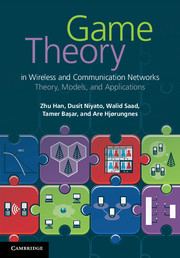Book contents
- Frontmatter
- Contents
- Preface
- 1 Introduction
- 2 Wireless networks: an introduction
- Part I Fundamentals of game theory
- 3 Non-cooperative games
- 4 Bayesian games
- 5 Differential games
- 6 Evolutionary games
- 7 Cooperative games
- 8 Auction theory and mechanism design
- Part II Applications of game theory in communications and networking
- References
- Index
3 - Non-cooperative games
from Part I - Fundamentals of game theory
Published online by Cambridge University Press: 25 October 2011
- Frontmatter
- Contents
- Preface
- 1 Introduction
- 2 Wireless networks: an introduction
- Part I Fundamentals of game theory
- 3 Non-cooperative games
- 4 Bayesian games
- 5 Differential games
- 6 Evolutionary games
- 7 Cooperative games
- 8 Auction theory and mechanism design
- Part II Applications of game theory in communications and networking
- References
- Index
Summary
Non-cooperative game theory is one of the most important branches of game theory, focusing on the study and analysis of competitive decision-making involving several players. It provides an analytical framework suited for characterizing the interactions and decision-making process involving several players with partially or totally conflicting interests over the outcome of a decision process which is affected by their actions. Examples of non-cooperative games are ubiquitous. In economics, firms operating in the same market compete over pricing strategies, market control, trading of goods, and the like. In wireless and communication networks, wireless nodes are involved in numerous non-cooperative scenarios such as allocation of resources, choices of frequencies or transmit power, packet forwarding, and interference management. Beyond economics and networking, non-cooperative game theory has made its impact over a broad range of disciplines such as biology, political science, sociology, and military tactics. In this chapter, we introduce non-cooperative game theory along with different types of games, while presenting underlying fundamental notions and key solution concepts.
Non-cooperative games: preliminaries
In this section, we introduce some preliminary concepts and terminology that pertain to non-cooperative game theory.
Introduction
A non-cooperative game involves a number of players having totally or partially conflicting interests in the outcome of a decision process. For example, consider a number of wireless nodes attempting to control their transmit power, given the interference generated by other nodes.
- Type
- Chapter
- Information
- Game Theory in Wireless and Communication NetworksTheory, Models, and Applications, pp. 55 - 100Publisher: Cambridge University PressPrint publication year: 2011



